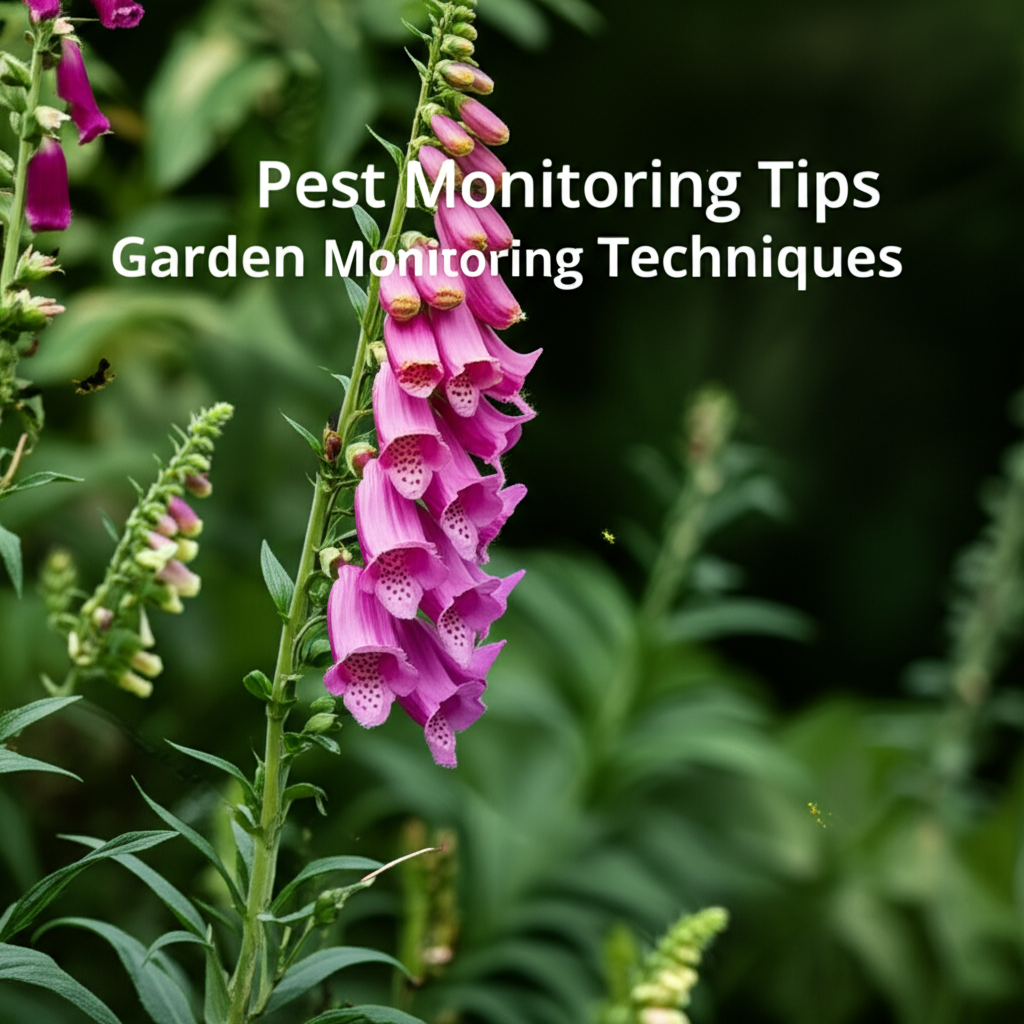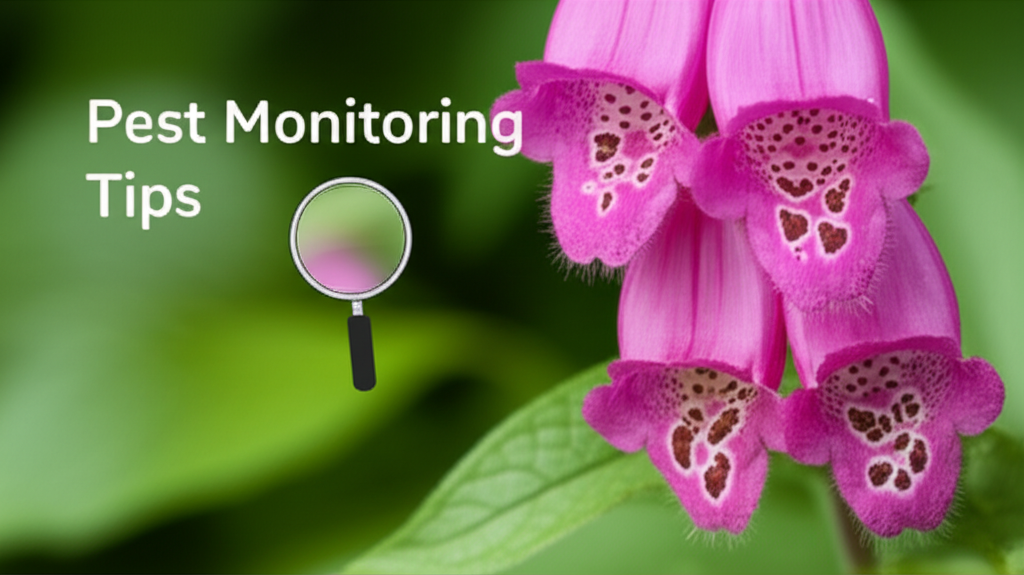Foxglove Beardtongue, scientifically known as Penstemon digitalis, is a captivating native perennial that graces gardens with its tall spires of bell-shaped flowers, typically white or pale lavender, from late spring through summer. Renowned for its drought tolerance and ability to attract pollinators like bees and hummingbirds, it’s a valuable addition to many landscapes. However, even robust native plants can fall victim to opportunistic pests. Vigilant monitoring is crucial for maintaining the health and beauty of your foxglove beardtongue, ensuring it thrives and continues to be a beacon for beneficial insects. This guide delves into effective pest monitoring techniques specifically tailored for Penstemon digitalis, empowering gardeners to identify, assess, and manage potential threats proactively.
Understanding Common Pests of Foxglove Beardtongue
While generally hardy, foxglove beardtongue can attract a range of common garden pests. Early detection is key to preventing significant damage. Understanding the typical culprits allows for targeted monitoring and swift action.
Insects Affecting Foliage and Flowers
Several insect species can target the leaves and blooms of foxglove beardtongue. These often manifest as chewed leaves, distorted growth, or visible insect presence.
- Aphids: Small, soft-bodied insects that cluster on new growth, stems, and flower buds. They feed on sap, causing stunting and yellowing. They also secrete honeydew, which can lead to sooty mold.
- Spider Mites: Tiny arachnids that are difficult to see with the naked eye. They thrive in hot, dry conditions and feed on plant sap, causing stippling (tiny yellow or white dots) on leaves. Severe infestations can lead to bronzing and leaf drop.
- Flea Beetles: Small, dark, jumping beetles that chew small, round holes in the leaves, giving them a “shotgun” appearance. They are particularly active in spring.
- Slugs and Snails: Mollusks that feed on leaves, leaving irregular holes and slime trails. They are most active at night and during damp conditions.
- Cutworms: Larvae that feed on young seedlings or the base of stems, often cutting them down at the soil line.
- Caterpillars: Various species of moth and butterfly larvae can chew on the leaves, sometimes defoliating plants if infestations are severe.
Pests Affecting Roots and Stems
While less common, some pests can impact the root system or lower stems of foxglove beardtongue, leading to general decline and wilting.
- Root Aphids: Similar to foliage aphids, but they infest the roots, weakening the plant and hindering water and nutrient uptake. Symptoms can include stunted growth and yellowing leaves.
- Whiteflies: Small, white, moth-like insects that congregate on the undersides of leaves. They feed on sap and can transmit plant diseases. Like aphids, they produce honeydew.
Key Pest Monitoring Techniques

Effective pest monitoring involves a multi-faceted approach, combining regular visual inspections with more systematic observation methods.
Regular Visual Inspections
The most fundamental technique is to regularly walk through your garden and observe your foxglove beardtongue plants.
- Frequency: Aim for at least once a week, but increase to every few days during periods of high pest activity (e.g., warm, dry spells for spider mites, or after rains for slugs).
- Areas to Inspect:
- Undersides of Leaves: Many pests, like aphids and spider mites, prefer the sheltered undersides of leaves.
- New Growth: Tender new shoots and buds are prime targets for aphids and other sap-sucking insects.
- Flower Stems and Buds: Inspect closely for any signs of insect clusters or damage.
- Soil Surface: Look for slugs, snails, or evidence of cutworm activity around the base of the plants.
- What to Look For:
- Presence of Insects: Actively look for the pests themselves.
- Damage Patterns: Recognize characteristic feeding marks (holes, stippling, chewed edges).
- Honeydew: A sticky residue on leaves, indicating the presence of sap-sucking insects like aphids or whiteflies.
- Webbing: Fine webbing on leaves can indicate spider mite infestations.
- Eggs: Pests often lay eggs in clusters on the undersides of leaves.
Using Tools and Aids for Enhanced Monitoring
Sometimes, pests are too small or too well-camouflaged for simple visual checks. Here are some tools to aid in detection.
- Magnifying Glass or Hand Lens: Essential for identifying small insects like aphids, spider mites, and their eggs. A 10x or 20x magnification is ideal.
- Sticky Traps:
- Yellow Sticky Traps: Effective for monitoring flying insects like whiteflies and aphids. Hang them near the plants.
- Blue Sticky Traps: Primarily used for thrips, which can also affect Penstemon.
- White Card or Paper: Gently tap a plant stem or leaf over a white card. Small insects dislodged will be easier to see against the white background.
Seasonal Monitoring Considerations
Pest activity fluctuates throughout the growing season. Adjusting your monitoring schedule based on the time of year can improve effectiveness.
- Spring: Focus on flea beetles and cutworms as new growth emerges.
- Late Spring/Early Summer: Aphids and spider mites can become prevalent, especially during dry spells.
- Summer: Continue monitoring for spider mites, aphids, and any leaf-chewing caterpillars.
- Fall: While generally less active, some pests might overwinter on plant debris, so clearing the area can help prevent future issues.
Table 1: Key Facts and Comparison of Common Foxglove Beardtongue Pests
This table provides a quick overview of common pests, their typical appearance, and the signs of infestation on foxglove beardtongue.
| Pest Name | Typical Appearance | Signs of Infestation | Preferred Conditions |
|---|---|---|---|
| Aphids | Small, pear-shaped, soft-bodied; green, black, or yellow. Often in clusters. | Stunted growth, yellowing leaves, sticky honeydew, sooty mold, curled leaves. | Cool, damp conditions in spring; then warm weather. |
| Spider Mites | Tiny (0.3-0.5 mm), red, brown, or yellow. Often hidden. | Stippling (tiny yellow/white dots) on leaves, webbing, bronzing, leaf drop. | Hot, dry, dusty conditions. |
| Flea Beetles | Small (1.5-3 mm), oval, black or metallic, jump when disturbed. | Numerous small, round holes in leaves (“shotgun” effect). | Warm, dry spring weather. |
| Slugs and Snails | Visible at night/dawn; slimy trails. | Irregular holes in leaves, slime trails on foliage and soil. | Moist, cool conditions; often at night. |
| Whiteflies | Tiny (1-2 mm), white, moth-like insects. Fly up when disturbed. | Yellowing leaves, stunted growth, sticky honeydew, sooty mold. | Warm to hot weather, often under leaves. |
Assessing the Severity of Infestations
Once pests are identified, it’s important to assess the level of infestation to determine the best course of action. Not every sighting requires intervention.
- Low Infestation: A few individual insects or minor damage on a small portion of the plant. Often manageable with natural controls or minor interventions.
- Moderate Infestation: Insects are present in larger numbers, or damage is more widespread, affecting a significant portion of the plant. May require more active management.
- Severe Infestation: Pests are numerous, and the plant shows significant signs of distress, such as widespread yellowing, wilting, defoliation, or deformed growth. Immediate action is usually necessary.
Consider the following when assessing:
- Plant Health: Is the plant otherwise healthy and vigorous? A strong plant can often tolerate minor pest issues.
- Beneficial Insects: Are natural predators like ladybugs, lacewings, or parasitic wasps present? These can help control pest populations naturally.
- Environmental Conditions: Are the conditions favorable for pest growth (e.g., drought for spider mites)? Addressing environmental factors can sometimes resolve pest issues.
Table 2: Monitoring Techniques, Actions, Pros, and Cons
This table outlines various monitoring techniques and potential actions, along with their respective advantages and disadvantages.
| Monitoring Technique | Action if Pests Detected | Pros | Cons |
|---|---|---|---|
| Visual Inspection (Weekly/Bi-weekly) | Observe and identify pests. Assess population size. | Cost-effective, no special equipment needed, early detection. | May miss small or hidden pests; requires consistent effort. |
| Magnifying Glass Inspection | Confirm pest identity, count individuals, check for eggs/larvae. | Accurate identification of small pests, helps in early detection of life stages. | Requires close proximity, time-consuming for large areas. |
| Yellow Sticky Traps | Monitor flying insects (aphids, whiteflies). Relocate traps if populations are high. | Attracts and captures flying pests, provides a visual count of mobile populations. | Non-selective (can catch beneficial insects); may not reflect overall infestation levels on plants. |
| Tapping Plant Over Card | Dislodge potential pests for easier identification. | Quickly reveals hidden or dormant pests on foliage. | Only effective for pests that are easily dislodged. |
| Soil Surface Check | Look for slugs, snails, or cutworm damage. | Directly identifies ground-dwelling pests and their feeding damage. | Limited to pests active at the soil surface; requires looking at base of plants. |
Preventative Measures and Best Practices
Proactive steps can significantly reduce the likelihood and severity of pest infestations on your foxglove beardtongue.
- Healthy Soil: Ensure your foxglove beardtongue is planted in well-draining soil amended with organic matter. Healthy plants are more resilient to pest attacks.
- Proper Watering: Water at the base of the plant to keep foliage dry, which discourages fungal diseases and can deter some pests. Avoid over- or under-watering, as stressed plants are more susceptible.
- Adequate Sunlight: Penstemon digitalis thrives in full sun. Ensure your plants receive at least 6-8 hours of direct sunlight daily.
- Good Air Circulation: Space plants appropriately to allow for good airflow, which can help prevent the spread of pests and diseases.
- Weed Control: Weeds can harbor pests and compete with your plants for resources. Keep the area around your foxglove beardtongue free of weeds.
- Attract Beneficial Insects: Plant companion flowers that attract natural predators of common garden pests, such as dill, fennel, yarrow, and cosmos.
- Garden Hygiene: Remove dead leaves and debris from around the base of your plants, as this can harbor overwintering pests and diseases.
When to Take Action: Thresholds and Intervention
It’s important to establish intervention thresholds – the point at which pest activity warrants action.
- Aphids: If more than 10-20% of the plant’s new growth is covered by aphids, or if honeydew production is significant, consider intervention.
- Spider Mites: If stippling is visible on more than 25% of the leaves, and mite populations are clearly increasing, action is advisable.
- Flea Beetles: If leaf damage is widespread and noticeable on a majority of plants, intervention may be needed to protect young plants.
- Slugs and Snails: If significant leaf damage is observed or if they are visibly damaging flower buds, control measures are recommended.
Integrated Pest Management (IPM) for Foxglove Beardtongue
An Integrated Pest Management approach combines various methods for sustainable pest control, prioritizing ecological balance.
- Cultural Controls: These involve adjusting gardening practices, such as those mentioned in preventative measures (healthy soil, proper watering, etc.).
- Biological Controls: Encourage or introduce natural enemies of pests. This can involve attracting beneficial insects or releasing them into the garden.
- Mechanical Controls: Physical removal of pests or using barriers. Examples include hand-picking slugs, using water jets to dislodge aphids, or applying sticky barriers.
- Chemical Controls (Last Resort): If other methods fail to bring pest populations under control, consider using pesticides. Always opt for the least toxic options first, such as insecticidal soaps, neem oil, or horticultural oils, and apply them according to label instructions, targeting only affected areas to minimize harm to beneficial insects.
By diligently monitoring your foxglove beardtongue plants using these techniques, you can catch pest problems early, assess their severity accurately, and implement appropriate management strategies. This proactive approach will ensure your Penstemon digitalis remains a healthy, vibrant, and attractive feature in your garden, continuing to support a thriving ecosystem.


